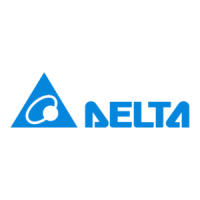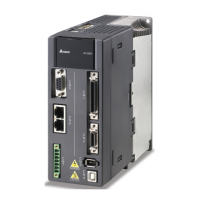What to do if write parameter error occurs: exceeds the limit of normal range on Delta ASD-A2-0421?
- DduncankevinAug 27, 2025
If the parameter setting value exceeds the limit of normal range, correct the PR command and parameter setting value.

What to do if write parameter error occurs: exceeds the limit of normal range on Delta ASD-A2-0421?
If the parameter setting value exceeds the limit of normal range, correct the PR command and parameter setting value.
What to do if data range error occurs when accessing CANopen PDO object on Delta Servo Drives?
If the data in the message has exceeded the data range of the specified object, NMT Maser send “Reset node“ command to its slave or reset the fault by sending the control word (0x6040) through CAN communication (the value of CANopen object 0x6040 should be reset).
What causes CANbus error on Delta ASD-A2-0421 Servo Drives?
A CANbus error on Delta Servo Drives is caused by CANbus off or Error Rx/Tx Counter exceeding 128. NMT Maser send “Reset node“ command to its slave or restart the servo drive.
What to do if there is a U, V, W, GND wiring error on Delta Servo Drives?
If there is a U, V, W, GND wiring error on Delta Servo Drives, it means that the wiring connections of U, V, W (for servo motor output) and GND (for grounding) are in error. Follow the wiring steps in the user manual to reconnect the wiring and ground the servo drive and motor properly.
What to do if CANopen PDO object does not support PDO on Delta Servo Drives?
If the specified object in the message does not support PDO, NMT Maser send “Reset node“ command to its slave or reset the fault by sending the control word (0x6040) through CAN communication (the value of CANopen object 0x6040 should be reset).
How to fix over current in Delta ASD-A2-0421?
If your Delta Servo Drive is showing an over current error, there are several potential causes and solutions: * A short circuit in the drive output: Eliminate the short circuit, ensuring no metal conductors are exposed. * Incorrect motor wiring: Rewire the motor following the wiring instructions in the user manual. * A faulty IGBT: Send the drive back to the distributors or contact Delta. * Incorrect control parameter settings: Reset to the default settings and then gradually adjust the values. * Unreasonable command: Use a less steep command or apply a filter to smooth the command.
How to resolve CANopen PDO is read-only and write-protected in Delta ASD-A2-0421?
To resolve CANopen PDO is read-only and write-protected in Delta Servo Drives, when the specified object in the message is write- protected, use NMT: Reset node or 0x6040.Fault Reset.
How to resolve Encoder does not complete the command which is issued by servo drive in Delta ASD-A2-0421?
If your Delta Servo Drives are showing that the encoder does not complete the command which is issued by servo drive because servo drive has not completely written barcode into encoder or the encoder does not complete the command issued by servo drive, correct the wiring.
What causes IGBT temperature error in Delta ASD-A2-0421?
An IGBT temperature error in Delta Servo Drives can occur if: * The drive has exceeded its rated load during continuous operation. If this is the case, increase motor capacity or reduce load. * There is a short-circuit at the drive output. If this is the case, ensure all wiring is correct.
What causes excessive deviation in Delta ASD-A2-0421 Servo Drives?
Excessive deviation in Delta Servo Drives can be caused by: * Maximum deviation parameter setting is too small. If this is the case, increase the parameter setting value of P2-35. * Gain value is too small. If this is the case, correctly adjust gain value. * Torque limit is too low. If this is the case, correctly adjust torque limit value. * There is an overload. If this is the case, reduce external applied load or re-estimate the motor capacity.
| Brand | Delta |
|---|---|
| Model | ASD-A2-0421 Series |
| Category | Servo Drives |
| Language | English |
Details the essential checks to be performed before using the servo drive and motor.
Lists the recommended circuit breakers and fuses for 220V and 400V series servo drives.
Details the procedures for inspecting the servo motor and drive before trial operation, covering appearance, wiring, and control switch status.
Provides instructions on ensuring correct wiring, understanding power circuits, and the initial display after powering on.
Provides detailed steps for tuning, including estimating inertia ratio, auto tuning, and semi-auto tuning, with corresponding flowcharts.
Explains position control, including PT and PR modes, pulse input types, filter settings, and gain adjustments.
Covers speed control, including command sources (analog, register), scaling, filters, and gain adjustments.
Details torque control, including command sources, scaling, and smooth torque command settings.
Details the different motion axes (Main Encoder, Auxiliary Encoder, Pulse Command, Capture, Compare, Master, Command, Internal Time, Synchronous Capture) and their attributes.
Explains the PR mode, including procedure triggering, command setting, and E-Cam function availability.
Explains the purpose and process of homing in PR mode, including coordinate value specification and software limits.
Covers parameter settings for target speed, acceleration/deceleration time, pause time, and PR parameters.
Explains the E-Cam function, its illustration, and compares it with machine cams in terms of structure, performance, accuracy, and maintenance.
Defines parameters, their grouping into eight categories, and communication address conventions.
Provides a comprehensive list of monitor, general output, filter, and gain parameters, including their abbreviations, functions, and related sections.
Details specific parameters such as firmware version, alarm code display, analog monitor output, and servo ON time.
Explains the serial communication capabilities of the servo drive for RS-485 and RS-232, including wiring descriptions.
Details essential communication parameters like address setting, transmission speed, protocol, and mechanism.
Explains MODBUS communication modes (ASCII, RTU), character structure, and error checking algorithms.
Lists various alarm codes for servo drives, their descriptions, corresponding DO signals, and servo status.
Details CANopen communication alarms, their descriptions, corrective actions, corresponding DO, and servo status.
Lists alarms related to motion control, including causes, checking methods, and corrective actions.
Provides a detailed breakdown of common causes for specific alarms (e.g., Over current, Over voltage) and their corrective actions.
Lists general corrective actions for various alarms, such as turning DI.ARST on or re-powering the servo drive.
Provides detailed specifications for ASDA-A2 series servo drives, including power, input current, output current, cooling, and control modes.
Lists specifications for ECMA series servo motors, covering different series (220V, 400V, medium/high inertia) and their electrical/mechanical properties.
Explains the system initialization procedure, including fault codes, coordinate system handling, and parameter settings.











